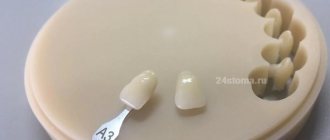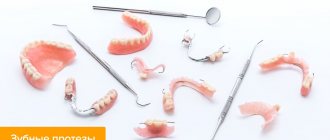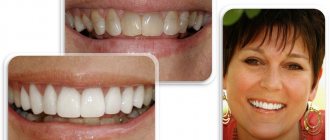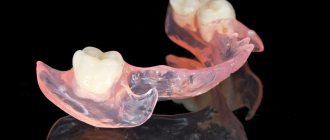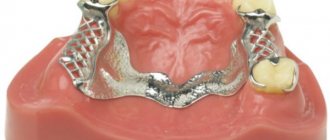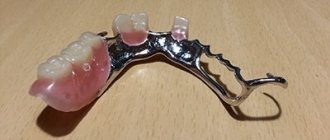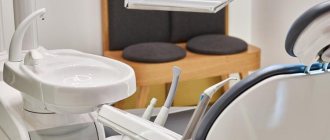Clasp prosthetics is a good alternative to implantation and has a number of advantages over bridge prosthetics. The most popular type is clasp dentures with clasps; this is a more budget-friendly option than those fixed with attachments; it is quickly manufactured and does not require additional grinding of the teeth. They are also used as splinting prostheses.
Clasp dentures on a turnkey basis without additional payments!
Clasp prosthesis on hooks - 40,000 rubles! Clasp prosthesis with locks - 70,000 rubles!
What is a clasp denture with clasps?
“Bugel” (German: bugel)
translated as “arc”. It is the arched metal frame that is the basis of the orthopedic design. A base saddle is welded to it, imitating gums and crowns, artificial teeth. Fixation in the mouth occurs by attaching hooks to the supporting teeth. Hooks are otherwise called clasps. Therefore, clasp dentures with hooks and dentures with clasps are one and the same.
A metal arch and a convenient fastening method have made it possible to reduce the volume of the prosthesis; it is not as massive as a plate one. It takes up less space in the mouth and you quickly get used to it. On the lower jaw it does not interfere with the tongue, it will not move the product from its place, and on the upper jaw it does not block the palate like the same removable acrylic one, which does not cause a gag reflex and does not interfere with talking. Speech is clear and without defects.
Hooks are often made of metal. This provides better fixation, but over time the enamel in the areas of contact may undergo changes. Sometimes technicians combine materials using nylon and acrylic. The first is prone to stretching, which can interfere with the stable retention of the prosthesis, and plastics break easily. In practice, it occurs when the distant supports are made of metal clasps, and in the frontal area they are made of white or transparent material to make the smile area more attractive.
Types and structure of clasps
Clasp fasteners can be retaining (settle under load, transfer pressure to the oral mucosa), support (evenly distribute pressure under load during clenching, unclenching teeth, talking, eating on the supporting teeth and gums), support-retaining. The latest (combined) types of hooks have a complex design:
- body (fixed element located in the upper part of the tooth);
- shoulders (adjacent in front and behind to the supporting units);
- occlusal overlay (a protective barrier that prevents the clasp from immersing in soft tissue and transfers the load to the supporting teeth);
- process (connects the hook to the base of the prosthesis).
Classification of clasps:
- round, flat, ribbon, semicircular (in shape);
- single-, double-armed, double-armed, single-linked, ring-shaped (according to the girth of the tooth);
- holding, supporting, supporting-holding (by function);
- cast and bent (according to technology and materials of manufacture).
The main advantage of clasp structures is the ability to remove them at night and provide rest to the oral mucosa and supporting teeth. Hooks on clasp dentures must meet a number of requirements: securely fix the structure, distribute the chewing load along the axis of the teeth and oral mucosa. Clasps should not affect teeth at rest; in case of periodontitis, they also have a fixing function.
Indications for installation
Clasp dentures on hooks are used in the following cases:
- in the absence of several teeth in a row;
- included defects (loss in different places of the jaw);
- end defects (no outer teeth);
- periodontal diseases and tooth mobility from this. The arc prosthesis splints and keeps them stationary;
- increased wear of crowns. The denture covers them, protecting them from further abrasion.
Many patients choose an arched prosthesis because they want to move away from the insufficiently comfortable plate one.
Functions assigned to the fixing element
Fixing prosthetic elements must perform 3 functions simultaneously:
- Support. The clasp always rests on the tooth and transfers part of the load to it when chewing.
- Holding/fixing. The overall structure remains motionless and does not fall off during chewing or talking.
- Coverage. If the prosthesis is in the mouth without a fixing device, it will soon move to the side and cease to perform its functions.
Clasps for dentures are an essential part of the structure, without which restoration of chewing function in full is impossible.
Contraindications
To install an orthopedic structure, support teeth are required, to which hooks are attached. That is, if you are completely edentulous, the clasp cannot be used. You can use the implantation service. Artificial teeth will securely hold the clasp denture with clasps, while restoring natural metabolic processes in the bone, preventing tissue atrophy.
The supporting teeth must be healthy and strong. They take on the burden of holding and chewing.
If you are allergic to metal, an orthopedic dentist may suggest a metal-free clasp prosthesis. If you are sensitive to other materials of the product, you should consult an allergist and choose with your doctor the best option for prosthetics or implantation.
Manufacturing stages
The production of a clasp clasp prosthesis takes place in several stages. The stages are divided into laboratory and clinical. Here's what happens during the clinical stages:
- examination of the patient, preparation of his teeth for prosthetics,
- grinding of abutment teeth to install crowns,
- taking impressions of the jaws,
- selection of shade of artificial teeth,
- protecting treated teeth with temporary crowns,
- production of permanent crowns and arches,
- fixation of crowns,
- frame fitting,
- fabrication of the structure in the laboratory,
- delivery of the finished prosthesis.
Laboratory stages:
- making a model based on the obtained plaster impressions,
- production of wax bases with occlusive rollers,
- drawing the frame onto the plaster model,
- duplication of this model,
- frame modeling,
- frame casting, subsequent processing,
- fitting the frame to the model,
- fitting of a metal frame by a patient,
- modeling the wax base, installing teeth on the structure,
- checking the clasp denture in the patient’s oral cavity,
- replacing the wax part with a plastic part, grinding and polishing,
- fitting and application of the finished prosthesis.
Caring for your prosthesis
In order for clasp dentures with hooks to maintain their original appearance for a long time, it is necessary to provide them with fairly simple care, which consists of simple steps:
- brush them twice a day with a brush and toothpaste without harsh abrasives;
- rinse your mouth after eating;
- have your dentures professionally cleaned once a year;
- come every six months for relocation to correct the correct chewing load and its uniform distribution;
- follow all doctor's recommendations;
- apply disinfectant antiseptic tablets, solution, where to place the prosthesis.
If part of the prosthesis or hooks breaks, immediately contact the dentist where the treatment and installation took place.
Advantages and disadvantages
For comparison, let’s take the clasp’s “classmates” - fixed bridges and removable plate prostheses. Clasp orthopedic structures, of course, are superior to plate ones in strength, but, like bridges, they are a temporary way to restore the dentition. Despite all the efforts of manufacturers, the clasp is not able to stop the loss of bone tissue, the inevitable decrease of which soon leads to changes in facial features and disturbances in the functioning of the dental system and internal organs. The obvious disadvantages of a removable clasp also include an aesthetic defect when installing a clasp prosthesis, when metal hooks attached to the teeth are visible, and a slow adaptation time to the design. In addition, any denture puts pressure on the gums and causes discomfort when chewing and hypoxia - a condition in which the gums do not have enough nutrition, which causes bone tissue to atrophy even faster. As for the service life of clasp dentures, compared to dental implants, it is quite short and is no more than 10 years. Subject to proper care and timely correction once a year.
Expert opinion
Roman Borisovich Alekperov
orthopedic dentist
Experience: 24 years
Advantages of clasps over attachments. When there is a need to restore the dentition, and the dental defects are scattered, the patient does not have enough financial resources, I recommend installing clasp dentures with clasps. You quickly get used to them, their production does not require much time, the chewing load is distributed on the teeth, and not on the gums, as is the case with lamellar ones. Yes, the aesthetics are insufficient because of the visible hooks, but you have teeth, you can eat, drink, and live a normal life.
Read also
Removable dentures: which ones are better?
Dental restoration using removable dentures can be an alternative to fixed structures.
What to do after tooth extraction: recommendations
Tooth extraction is an invasive dental procedure that requires a recovery period.
Price
The average cost of a clasp denture with clasps is 35,000 rubles, when choosing a metal-free base (acrifri) - from 60,000 rubles. This includes the material, the work of the dental technician, fitting, and correction. The number of missing teeth in this type of prosthetics does not greatly increase the price. Whereas when fixing with locks, it is interconnected with the number of supporting teeth, and directly with the production of crowns on them.
Other jobs
How much does a clasp prosthesis cost?
The price of lower jaw prosthetics using a clasp design depends on the following factors:
- base and frame material;
- the number of teeth that need to be restored with a prosthesis;
- material for dental crowns.
The average price of a clasp prosthesis is from 32,000 rubles. The price, as a rule, already includes payment for the prosthesis itself, treatment planning, installation of the system, and check-ups with the dentist.
Clasp dentures are an inexpensive and accessible way to restore a smile with a long service life (more than 10 years).
Telescopic fixation system
This fastening system is the most complex and modern. In this case, telescopic crowns are made of two parts in contact with each other. One part of the crown (lower, non-removable) is installed in the supporting teeth, and the other (upper, removable) is firmly fixed to the metal plate of the clasp.
When fastening, the upper part of the telescopic crowns fits tightly onto their lower part. Shrinkage of the fastening when installing a removable structure ensures reliability and strength of fixation. And although this type of fastening is not cheap, it serves reliably for a long time and only needs minor correction.
Unfortunately, for Russia this type of fastening is still new and is used infrequently. To work with these types of clasp fastenings, you need a highly qualified orthodontist. But in America and Europe, telescopic mounts are already common and familiar.
Requirements for clasps
When choosing a fixation structure in the patient’s mouth, you need to take into account the requirements that it must fully comply with:
- type of fixation - materials must be the same for all supporting teeth;
- the prosthesis does not tip over or rotate after it is installed in the mouth;
- when closing the jaws and chewing, no injury to the supporting units occurs;
- preserving the aesthetics of a smile - metal hooks are unlikely to retain their beauty when installed on the front teeth.
Important! The purpose of clasps is to ensure the immobility of the prosthetic structure, but the doctor must take into account that they can be installed only if the units do not have pathological mobility (do not wobble) and have the correct anatomy of the coronal part.
Prices
| Service | Price |
| Consultation + treatment plan | |
| Clasp prosthesis | 47 700 ₽ |
| Quadrotti | from 57,100 ₽ |
| Splinting | 52 150 ₽ |
Expert of the article you are reading: Natalich Boris Anatolyevich Chief physician, CMN, doctor of the highest category, orthopedist, surgeon, implantologist, leading specialist of the NovaDent network
38 years
Clinical experience
Otradnoe
st. Khachaturyan, 7
+7 +7
Free consultation with this specialist
How clasps are made
The structures in question are made in a dental laboratory, and first you need to choose one from all the varieties. Most often, such fixing elements are made from base metals. Any type of hook is bent with pliers, tongs or round nose pliers - it is given its original shape. Then the metal element is “implanted” into the base and the prosthesis is given to the patient to try on and, if necessary, the product is adjusted.
Important! Thorough polishing of the metal in the element that is adjacent directly to the tooth is required: the material should not injure the enamel or serve as a place for plaque accumulation. But the process, on the contrary, is covered with small notches, which ensure its reliable fixation with the acrylic base.
Clasps are an integral part of a removable denture, which has an extensive classification. The choice of a specific model is made by the dentist, because it is important to take into account not only the financial capabilities of the patient, but also the condition of the supporting teeth, gums and alveolar process.
Advantages of clasp structures
So, patients and orthodontists note the following advantages when using clasp structures:
- Comfortable: The thin metal base arch allows the palate to be open. This ensures that patients can continue to enjoy food and live in style.
- The use of a metal arch does not interfere with diction and prevents unpleasant moments associated with the sudden loss of the prosthesis.
- Strength: the strength of the arch allows you to protect the prosthesis from breakage.
- Duration of service: up to 5 years of wearing the structure, which is considered a record period for removable dentures (for plastic types, the wearing period usually does not exceed 2-2.5 years).
- Slowing down the atrophic processes in the gums and jaws, which preserves the possibility of wearing the plates for the longest possible time.
- There is no need for daily removal at night.
- Rare cases of stomatitis.
- A splinting prosthesis on clasps allows you to strengthen teeth when they become loose.
- Excellent fixation of the prosthesis with different types of fastenings (clasp, lock or telescopic system).
pros
Unlike soft removable dentures, arch structures do not rub the gums and do not cause long-term addiction. Due to the tight fixation, the mobility of the product in the mouth is eliminated. The structure of the prosthesis does not block the palate - this preserves taste sensations during meals. In addition, the clasp denture does not block the movement of the tongue in the mouth. This does not distort diction and does not cause spasms of the facial muscles.
The distribution of load during chewing of food occurs according to the “one to two” principle. That is, one-third of the pressure is on the support unit and two-thirds on the beam system. The arc takes away part of the load, which protects soft tissues from damage and deformation. In classic removable dentures, the chewing load is directed to the gums and palate.
The structural features of the clasp prosthesis determine its shelf life. With proper care, the product will last at least 7 years, while soft prostheses provide functionality for up to 5-6 years. In the absence of a frame in soft removable dentures, the prosthetic bed quickly collapses.
Another advantage of the design is the possibility of parallel dental treatment with a prosthesis installed. Such products are called splinting - they simultaneously replace missing teeth and tightly fix existing ones.
Components of the clasp
The simplest holding clasp consists of 3 parts - the shoulder, the body, and the appendage.
A more complex version, the support-retaining one, consists of a shoulder, an occlusal pad, a body and a process. This composition is typical for the classic type of support-retaining clasp called Akker.
The arm of the clasp is the part that holds it on the tooth.
The body of the clasp connects all the elements together.
The process or connecting rod is an element that coppers the prosthesis and the clasp itself. And the size of the process depends on the type of prosthetics.
And the foot or occlusal pad is a kind of transmitter of chewing force on the tooth at the level of occlusion.
Features of clasp prosthetics on the upper and lower jaws
The differences between the upper and lower dentures lie in the location of the bridge and retainers. The arch model depends on the topography of the dentition defect, the shape of the palate, the relief of the alveolar process and other factors.
When restoring the upper jaw, the thickness of the bridge should be 0.9-1.2 mm and the width 4-10 mm. In this case, the arc should be located 0.5 mm from the mucosa. In most cases, the upper jaw prosthesis is fixed on the lateral incisors or molars.
The lower jaw prosthesis must be made with an arch that is unevenly spaced from the mucous membrane: at the upper edge it extends by 0.5-0.6 mm, at the lower edge - by at least 1 mm. In this case, the jumper should not come into contact with the underlying tissues and injure the frenulum. In most cases, the structure is attached to the lateral incisors.

